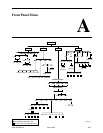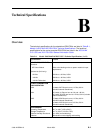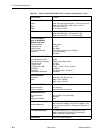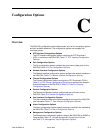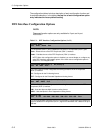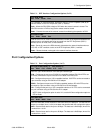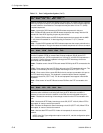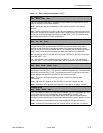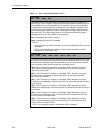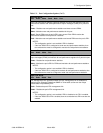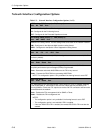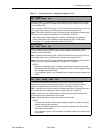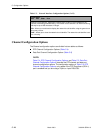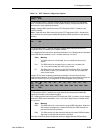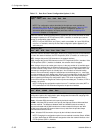
C. Configuration Options
3160-A2-GB24-10 March 2001
C-5
Rcv Yellow: Halt
Next None Halt Prev
Action on Network Yellow Alarm. Specifies the action taken on this port when a Yellow
Alarm is received on the network interface.
None
– Makes the data port unaffected by Yellow Alarms received on the network
interface.
Halt
– Stops the transmission of data on the port and disables the data port when Yellow
Alarms are received on the network interface. When Yellow Alarms are received, all ones
are sent on the Received Data interchange circuit BB (CCITT 104). The Clear-to-Send
interchange circuit CB (CCITT 106) is interrupted.
Tx Clock: Int
Next Int Ext Prev
Data Port Transmit Clock. Specifies whether the transmitted data for the port is clocked
using an internal clock provided by the DSU/CSU (synchronized to the clock source
specified by the clock source configuration option in the General configuration option
group) or an external clock provided by the DTE connected to the port. When an external
clock is used, it must be synchronized to the same clock source as the DSU/CSU.
Int
– Indicates the clock is provided internally by the DSU/CSU on the TXC interchange
circuit DB (CCITT 114).
Ext
– Indicates the clock is provided externally by the DTE on the XTXC interchange
circuit DA (CCITT 113). Use this selection when the clock source is set to this data port.
InvertTxC: Auto
Next Auto Enab Disab Prev
Invert Transmit Clock. Specifies whether the clock supplied by the DSU/CSU on the TXC
interchange circuit DB (CCITT 114) is phase inverted with respect to the Transmitted Data
interchange circuit BA (CCITT 103). This configuration option is useful when long cable
lengths between the DSU/CSU and the DTE are causing data errors.
Auto
– The clock is automatically phase inverted if required for optimum data
transmission.
Enab
– Indicates TXC supplied by the DSU/CSU on this port is phase inverted.
Disab
– Indicates TXC supplied by the DSU/CSU on this port is not phase inverted.
InvrtData: Disab
Next Enab Disab Prev
Invert Transmitted and Received Data. Specifies whether the port’s transmitted data and
received data are logically inverted before being transmitted or received. This
configuration option is useful for applications where HDLC data is being transported.
Inverting the data ensures that the density requirements for the network interface are met.
Enab
– Indicates the transmitted data and received data for this port are inverted.
Disab
– Indicates the transmitted data and received data for this port are not inverted.
Table C-2. Port Configuration Options (3 of 5)



